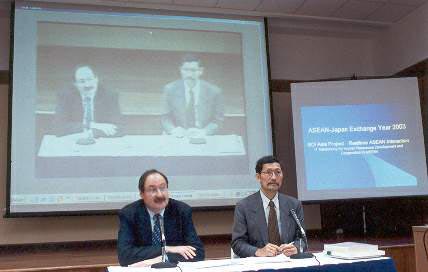Real-time ASEAN Interaction
IT Networking for Human Resources Development and Cooperation in ASEAN

AIT President, Prof. Jean-Louis Armand, delivers an opening remark at the conference. Also in the photo is Prof. Gothom Arya, Registrar.
On February 20, the younger generation from Myanmar and other ASEAN countries had a chance to discuss and share their views through a video conference on 'Real-time ASEAN Interaction: IT Networking for Human Resources Development and Cooperation in ASEAN'. The Video Conference was conducted by the University of Computer Studies, Yangon (UCSY), Myanmar, in collaboration with AIT. The video conference was part of the ASEAN-Japan Exchange Year 2003, a project initiated by Prime Minister Junichiro Koizumi of Japan during his visit to Southeast Asian countries last January. Through the cooperation of the Embassy of Japan in Myanmar, this commemoration program used the SOI-Asia network. UCSY, where the first academic Internet connection in Myanmar was made by SOI-Asia, provided the transmission station for this conference.

From left: Mr. Atsushi Ozu, Second Secretary, the Embassy of Japan; Mr. Masahiro Mikami, Counsellor, the Embassy of Japan; Mr. Jean-Philippe Thouard, Assistant to President, AIT; Prof. Jean-Louis Armand, AIT President; and Ms. Sakaya Fukuda of Asia Science and Education for Economic Development Institute (SEED).

Prof. Jun Murai, Chairman of SOI-Asia, and Keio University Professor, shares his view through the internet.
The event, chaired by Prof. Jun Murai, Chairman of SOI-Asia, and Keio University Professor, started with opening remarks from the Ministry of Science and Technology, Myanmar, Prof. Dr. Pyke Tin, followed by opening messages by H.E. Dr. Surapong Suebwonglee, Minister of Information and Communications Technology, Royal Thai Government; Mr. Koinuma, Minister of the Japanese Embassy in Myanmar; and by AIT President Prof. Jean-Louis Armand.
Prof. Jun Murai of Keio University, Japan, gave a keynote speech on 'The Impact of Networking in the Human Resources Development' mentioning three major aspects for the Internet. First, he discussed the proper use of the Internet in education, suggesting that researchers in Asian countries work together and accumulate experiences by themselves to make use of the Internet for education to happen. Second, researchers need to share their work results with many people in the region. Third, they need to think about the future challenges of IT and the distribution to other parts of society and other parts of the world.
A panel discussion followed, with Prof. Michio Umegaki of Keio University, Japan; Dr. Pichet Durongkaveroj, E-ASEAN Working Group, Thailand; a faculty from UCSY; Dr. Kanchana Kanchanasut, DEC Director, AIT; and Prof. Gothom Arya, AIT Registrar, sharing their views on ICTs. Prof. Umegaki mentioned pros and cons, and raised some questions about the nature of education in the 21st century, and how to make human contacts by using e-learning. Dr. Pichet shared his extensive experience of living in many countries in ASEAN. He mentioned that all countries in the region are very keen to develop their own capacity in ICT, and Japan has been of much help in these endeavors.
Views on IT education and training and HRD in Myanmar were shared by a faculty member from UCSY, Myanmar. She said to disseminate IT knowledge to students nationwide, the Myanmar Government has established multimedia classrooms and computer laboratories in middle and high schools. Now multimedia classroom have been successfully installed at 455 existing schools throughout Myanmar, and a total of 151 colleges, universities and institutes in Myanmar now have IT learning centers, electronic resources centers and computer training centers.

From left: Dr. Kanchana Kanchanasut, DEC Director, AIT; Dr. Pichet Durongkaveroj, E-ASEAN Working Group, Thailand; and Prof. Gothom Arya, Registrar.
Dr. Kanchana shared her experience in Internet development, especially in research and development. She noted that the Internet in the Asia-Pacific region originally started in universities and research institutions. Initially, it was hampered by traditional budget funding and bureaucracy. But, with hard work and strong efforts, research and education networks were formed. When the Internet became popular, and became commercial, government people started to understand about IT.
After the panel discussion, a floor session was open to 10 students from ASEAN countries and Japan to present their views and plans on the topic, 'Assuming that broadband Internet connection is available in the future ASEAN, what are your plans to use it for Human Resource Development in your university, your country, or in the region?' AIT student representatives from Cambodia, Lao PDR, Myanmar, Philippines, and Thailand at AIT, expressed their views. They commented that broadband Internet connections could be used for various purposes, such as education, human resources management, international exchange and knowledge development, among other uses.
They suggested that governments in the region must play an important role to upgrade the infrastructure in their countries (such as electricity and telephone networks), which is still hindering the spread of Internet. Also to make this broadband Internet connection more fruitful, English proficiency among populations in the region should be improved. More training on the Internet and computer proficiency are also necessities, especially in remote areas.
Students added that investment in human resources should focus on the processes by which the productive capacity of human resources can be increased by upgrading their quality through education and training. IT networks could facilitate informal education and distance learning, by saving time, energy, and money.
